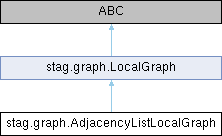 |
STAG Python
2.0.2
Spectral Toolkit of Algorithms for Graphs
|
 |
STAG Python
2.0.2
Spectral Toolkit of Algorithms for Graphs
|

A local graph backed by an adjacency list file on disk.
The graph is loaded into memory in a local way only. That is, an adjacency list data structure is constructed in memory as node neighbours are queried. If a node is not found in the cached adjacency list, then the neighbours of the node are queried from the adjacency list on disk. This allows for local algorithms to be executed on very large graphs stored on disk without loading the whole graph into memory.
See Graph File Formats for more information about the adjacency list file format.
Public Member Functions | |
| def | __init__ (self, str filename) |
| Construct a local graph backed by an adjacency list file. | |
| float | degree (self, int v) |
| Given a vertex v, return its weighted degree. | |
| int | degree_unweighted (self, int v) |
| Given a vertex v, return its unweighted degree. | |
| List[Edge] | neighbors (self, int v) |
| Given a vertex v, return a list of edges representing the neighbors of v. | |
| np.ndarray | neighbors_unweighted (self, int v) |
| Given a vertex v, return a list of neighbors of v. | |
| bool | vertex_exists (self, int v) |
| Given a vertex ID, returns true or false to indicate whether the vertex exists in the graph. | |
| np.ndarray | degrees (self, np.ndarray vertices) |
| Given a list of vertices, return a list of their weighted degrees. | |
| np.ndarray | degrees_unweighted (self, np.ndarray vertices) |
| Given a list of vertices, return a list of their unweighted degrees. | |
| def | __init__ (self) |
| Default LocalGraph constructor. | |
| float | degree (self, int v) |
| Given a vertex v, return its weighted degree. | |
| int | degree_unweighted (self, int v) |
| Given a vertex v, return its unweighted degree. | |
| List[Edge] | neighbors (self, int v) |
| Given a vertex v, return a list of edges representing the neighbors of v. | |
| np.ndarray | neighbors_unweighted (self, int v) |
| Given a vertex v, return a list of neighbors of v. | |
| np.ndarray | degrees (self, np.ndarray vertices) |
| Given a list of vertices, return a list of their weighted degrees. | |
| np.ndarray | degrees_unweighted (self, np.ndarray vertices) |
| Given a list of vertices, return a list of their unweighted degrees. | |
| bool | vertex_exists (self, int v) |
| Given a vertex ID, returns true or false to indicate whether the vertex exists in the graph. | |
| def stag.graph.AdjacencyListLocalGraph.__init__ | ( | self, | |
| str | filename | ||
| ) |
Construct a local graph backed by an adjacency list file.
The adjacency list file must not be modified externally while it is in use by this object.
| filename | the name of the adjacency list file which defines the graph. |
Reimplemented from stag.graph.LocalGraph.
| float stag.graph.AdjacencyListLocalGraph.degree | ( | self, | |
| int | v | ||
| ) |
Given a vertex v, return its weighted degree.
Reimplemented from stag.graph.LocalGraph.
| int stag.graph.AdjacencyListLocalGraph.degree_unweighted | ( | self, | |
| int | v | ||
| ) |
Given a vertex v, return its unweighted degree.
That is, the number of neighbors of v, ignoring the edge weights.
Reimplemented from stag.graph.LocalGraph.
| List[Edge] stag.graph.AdjacencyListLocalGraph.neighbors | ( | self, | |
| int | v | ||
| ) |
Given a vertex v, return a list of edges representing the neighbors of v.
The returned edge objects will all have the ordering (v1, v2) such that edge.v1 = v.
| v | the ID of some vertex in the graph |
Reimplemented from stag.graph.LocalGraph.
| np.ndarray stag.graph.AdjacencyListLocalGraph.neighbors_unweighted | ( | self, | |
| int | v | ||
| ) |
Given a vertex v, return a list of neighbors of v.
The weights of edges to the neighbors are not returned by this method.
| v | the ID of some vertex in the graph |
Reimplemented from stag.graph.LocalGraph.
| bool stag.graph.AdjacencyListLocalGraph.vertex_exists | ( | self, | |
| int | v | ||
| ) |
Given a vertex ID, returns true or false to indicate whether the vertex exists in the graph.
| v | the vertex index to check |
Reimplemented from stag.graph.LocalGraph.
| np.ndarray stag.graph.AdjacencyListLocalGraph.degrees | ( | self, | |
| np.ndarray | vertices | ||
| ) |
Given a list of vertices, return a list of their weighted degrees.
When developing implementations of the stag.graph.LocalGraph class, providing an efficient method of returning a list of degrees will improve the performance of local clustering algorithms.
| vertices | a list of IDs representing the vertices to be queried |
Reimplemented from stag.graph.LocalGraph.
| np.ndarray stag.graph.AdjacencyListLocalGraph.degrees_unweighted | ( | self, | |
| np.ndarray | vertices | ||
| ) |
Given a list of vertices, return a list of their unweighted degrees.
When developing implementations of the stag.graph.LocalGraph class, providing an efficient method of returning a list of degrees will improve the performance of local clustering algorithms.
| vertices | a list of IDs representing the vertices to be queried |
Reimplemented from stag.graph.LocalGraph.